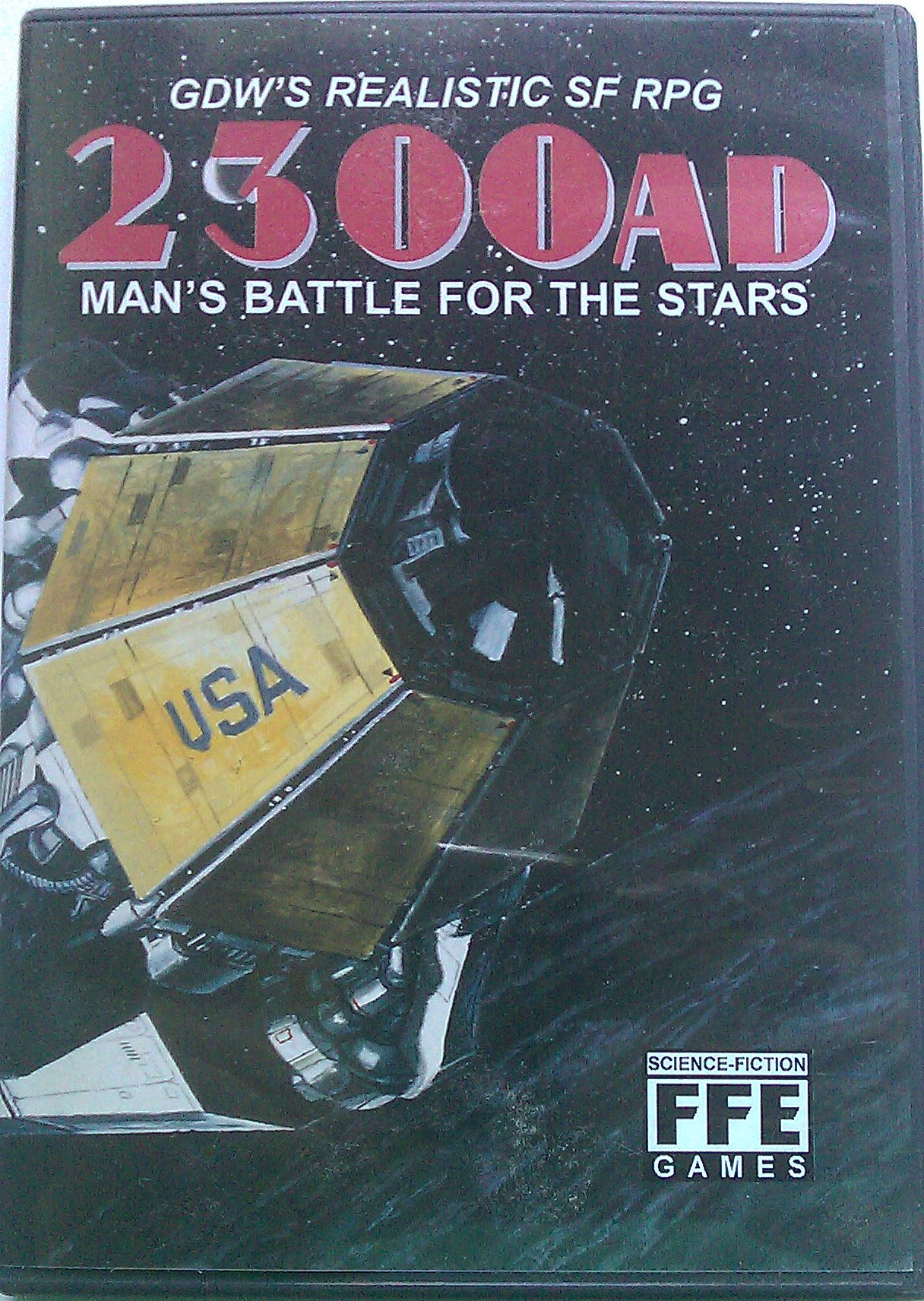CD-ROM: 2300 AD
This article originally appeared in the May/June 2012 issue of Freelance Traveller.
 2300
ad CDROM. Various
authors.
2300
ad CDROM. Various
authors.
FarFuture Enterprises http://farfuture.net
PDF and other files on CD/DVD, ~680MB
US$35
As part of their efforts to make electronic versions of all of GDW’s SF RPGs (and all versions of Traveller) available, FarFuture Enterprises has released the entire GDW corpus for their Traveller:2300/2300 AD series. In spite of the original name (Traveller: 2300), this was a ‘sequel’ to their Twilight: 2000 setting, rather than a ‘prequel’ to the Traveller setting; the name was changed to 2300 AD for the second edition to reduce the confusion and address the objections of the by then well-established Traveller community, which did not receive the product well (largely because of the ‘misleading’ name. As 2300 AD, it established a strong community of its own, with some overlap with the extant Traveller community, that still exists today).
It should be noted that this material is not directly compatible with the recently-released 2300 AD product from Mongoose Publishing; rather, that product is an authorized re-working and updating of some of this material, made compatible with their version of the Traveller system (and ironically making the original name of Traveller: 2300 entirely appropriate, though they quite reasonably chose to maintain the better-established 2300 AD name).
On the Shelf
The product is only available via FarFuture’s website, so the only shelf you’ll see it on is the one you put it on. What you’ll get is a LightScribe-printed disc in a DVD (paperback-sized) case, like with the other FFE CDROMs.
Initial Impressions
If you have autorun capability, you’ll see that your browser should be started, and a page loaded off the disc. This page doesn’t use any special capabilities of advanced browsers; all it requires is the basic ability, established with NCSA Mosaic, to display text, links, and graphics—although with a couple of minor alterations, even the graphics could be dispensed with, and lynx or other pure-text browsers would be usable. (If you don’t have autorun, or have it disabled, load “2300AD.html” or “index.html” into your browser of choice. We'll refer to either of these pages—which are the same—as “the index page” henceforth.)
The browser and index page turn out to be essential if you intend to use the material directly off the disc, rather than copying it to dynamic media such as your computer’s hard disc or a USB ‘thumb’ drive. This is because the file names on the disc do not provide the product names; instead, they are all numeric. The index page provides the titles of each publication in the series as a link (to the actual product file), along with a one-line text description of what the product is. You will need a program that can display PDF files, one that can display Microsoft Word documents, and one that can display plain text documents; a graphics program that can display GIF and JPG files will be useful (though recent browsers are adequate for graphic display, especially if they let you zoom in on the graphic).
(Obviously, if you copy the files to a hard disc or a thumb drive, you can then rename the files—but this will, equally obviously, break the links on the index page.)
On Closer Inspection
The material is “text behind scans” rather than the actual text in the file being displayed directly; the scans are clear enough to be easily readable, and I suspect that if I wanted to take the time and go to a font identification site, I would have a high probability of correctly identifying the font from the scans. Artwork is also clear, with little of the ‘smudging’ that often occurs when the scan doesn’t match the original resolution.
You get the complete canon, which in addition to all of the GDW-label Traveller: 2300 and 2300 AD products includes one third-party licensed product and all of the 2300 AD articles from Challenge magazine, plus supplemental material including a TrueType font for the 2300 AD titles (which we used on this months cover), and documents describing ‘the game’ that the GDW staff used to develop the setting, starting on the eve of World War III in 1995, and continuing to 2300.
The readme file states that the text of the PDFs is searchable, but not completely spell-checked, and that the PDFs are “unlocked”.
The disc as released has some minor flaws; one file is missing completely, another is incorrectly located, and there are a couple of mysterious files and one folder that are never referenced or used. These flaws do not at all prevent the disc from being usable; you will simply not have the “Graphic Overview of the file contents of this CD-ROM”, and the FFE logo that links to the FFE CDROM website will display as a missing/broken graphic.
Conclusion
The system developed for use in the original 2300 AD is not compatible with the contemporary Traveller system nor the modern one. The author of the Mongoose 2300 AD sourcebook did, however, make a strong effort to keep the setting material mostly compatible. As a result, this disc can’t be said to be a waste of money for people interested in the 2300 AD setting, whether new to it because of Mongoose’s efforts, or returning to it with fond memories. It is a setting which this reviewer perceives as having a more militaristic bent than the stock Traveller settings, and the setting has much more of a ‘frontier feel’ than the classic Third Imperium, but in the final analysis, it should be just as playable for multiple adventure genres, and just as entertaining. If you’re willing to put in a little effort for conversion, there’s no reason not to purchase this to use with Mongoose Traveller’s 2300 AD.
 Freelance
Traveller
Freelance
Traveller